#fish essay
Text
What Is and Isn't a Fish: a List
A list of the animals I discussed in my fish essay, but for those who don't want to scroll through paragraphs of text to find out if an animal is or isn't a fish. Just CTRL+F your way through here!
I'll add onto here more animals whenever I get asked about them being fish. See my fish essay here!
Some notes before you proceed:
Yes, all tetrapods are fish! We are phylogenetically fish, as we are and our ancestors were lobe-finned fish! "Fish" in the phylogenetic sense is a paraphyletic group if you try to exclude tetrapods, so it is frankly impossible.
How come tetrapods aren't listed as fish then? Long answer, read my essay. Short answer, me and other fish accounts tend to operate on the morphological definition of fish, so does most of the world. Here I use the morphological definition of "fish".
Fish:
Jawless fish
Hagfish
Lamprey
Cartilaginous fish
Sharks
Dogfish
Whale shark
Chimaeras/Chimeras/Ghost sharks
Ratfish
Ray
Stingray
Skate
Ray-finned fish
Teleosts
Catfish
Eels
Moray eel
Seahorse
Sea dragon
Lobe-finned fish
Coelacanth
Lungfish
Not Fish:
Crustaceans
Krill
Shrimp
Crab
Crayfish/Crawfish/Crawdad
Lobster
Spiny lobster
Triops
Mantis shrimp
Barnacle
Isopod
Copepod
Shellfish
Mollusks/Molluscs
Gastropods
Sea snail
Sea slug
Snails and slugs in general
Sea angel
Sea hare
Sea bunny
Cephalopods
Octopus
Squid
Cuttlefish
Nautilus
Inkfish
Bivalves
Clam
Mussel
Scallop
Oyster
Chiton
Chelicerates
Horseshoe crab
Sea spider
Water mite
Diving bell spider
Cnidarians
Jellyfish/Sea jelly/Jelly
Coral
Sea anemone/Anemone
Siphonophores
Portugese man o' war
Echinoderms
Sea cucumber
Sea pig
Feather star
Sand dollar
Sea biscuit
Sea cookie
Brittle star/Serpent star
Sea urchin
Starfish/Sea star
Comb jelly
Lancelet
Tunicates
Sea squirt
Salp
Annelids
Bristle worm
Bobbit worm
Spoon worm
Giant tube worm
Bone-eating worm
Sea mouse/Sea mice
Feather duster worm
Christmas tree worm
Leech
Flatworm
Amphibians
Salamander
Amphiuma
Mudpuppy/Mud puppy
Waterdog
Olm
Axolotl
Siren
Frog
Toad
Tadpole
Caecilian
Reptiles
Sea snake
Water snake
Snakes in general
Sea krait
Turtle
Snapping turtle
Softshell turtle
Sea turtle
Terrapin
Marine iguana
Crocodilian
Crocodile
Alligator
Caiman
Gharial
Bird
Penguin
Seagull
Loon
Swan
Mammals
Whale
Orca
Baleen whale
Toothed whale
Dolphin
River dolphin
Porpoise
Narwhal
Beluga whale
Sperm whale
Pinniped
Seal
Sea lion
Leopard seal
Elephant seal
Walrus
Sirenian
Manatee
Sea cow
Dugong
Otter
Sea otter
Beaver
Hippo
Platypus
Muskrat
Water shrew
323 notes
·
View notes
Text

give them cozy hoodies NEOOWWWWW
#rain world#five pebbles#looks to the moon#no significant harassment#seven red suns#ILL WORK ON ESSAY NOW I SWEAR#art#fish makes art
1K notes
·
View notes
Text
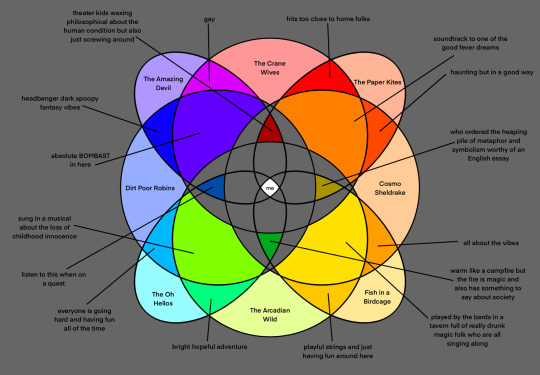
I was compelled last night and I’m quite honestly scared of whatever 11:59 PM me intended for those middle sections. At least I still know my colors when sleep deprived, and I’m sure someone else on here can fill the blank spots out better than I can on a full eight hours of shut-eye.
#oh god on high what do i tag this with#the crane wives#the paper kites#cosmo sheldrake#fish in a birdcage#the arcadian wild#the oh hellos#dirt poor robins#the amazing devil#venn diagram#me running my mouth#im pretty sure you could put all the text boxes in this file in a jar shake it to hell and back and pour it over the diagram#and itd still make some degree of sense#says a lot about my music taste eh mates?#anyone who sees this and relates to any degree please o please say so#i have essays worth of analysis i can spit out about most of these musicians#not on command though i need to get kinda existential first#theres three paragraphs about the eurus ep hanging out in my drafts and i think my motivation for that is somewhere behind the couch#with the spiders and my childhood nail clippings
59 notes
·
View notes
Text


Ladies and gentlemen (and, creatures), I have finished my second PD villagers line-up! My favorites to do were Molly and Emmalyn they're just <3
(I also re-did my first line-up with some minor changes since my art skills have improved since).
#also I fucking love how I did Cadenza but if I talk abt her its gonna be a whole ass 30 pg essay so that's for another post#also we need to recognize visher more yall are missing out on the fishing dilf#I like to think him and dale have a rivalry or smthn#mcd#minecraft diaries#aphmau#aphblr#mcd emmalyn#mcd molly#mcd cadenza#cadenza zvahl#mcd visher#art#character design#fan art
638 notes
·
View notes
Text
Thinking about love in season 2 of The Bear and how Carmy seems to conceptualize "love" and "fun" as opposites — because for him, they historically have been. It's something I really noticed in Fishes (2x06): how vocally and genuinely everyone in his family — including in-laws and functionally adoptive members like Richie and the Fak siblings — loves each other, but also how deeply entwined that love is with stress and chaos and criticism.
Natalie is nicknamed, by people who love her, after a mistake she made years ago and which is still held over her head when she tries to help in the kitchen. Donna loves her children and is loved by them in turn, but she's constantly on the edge of a meltdown, unable to offer or accept support. She spends hours cooking them a beautiful dinner, and then she drives a car through the wall. Michael reminds Carmy he loves him and tries to give him advice, and then he gets in a massive fight with Uncle Lee at the dinner table and starts throwing forks. Cooking is clearly so important to his family, but doing this activity they love, and especially doing it around the people they love, so rarely results in a feeling of "amusement or enjoyment."
And so it's no surprise, really, that the career Carmy loves is one that gives him panic attacks and made him throw up before work every day, or that he (and Natalie and Sydney) not only decide on such a radical transformation of the restaurant but give themselves a ridiculously sort timeline to complete it. He's stressed and miserable a lot of the time, but is it really something he loves if he doesn't feel that way?
#the bear#the bear s2 spoilers#carmy berzatto#slightly unformed bc i just finished watching and my brain spat this out#side note: i think this association between love and chaos is why the family but especially carmy has such a problem with pete#he's too normal and sweet#everyone claims not to understand the 7 fishes but he's the only one who threatens the tradition by bringing an 8th fish#he's also the only one who never calls natalie sugar#i'm not actually that invested in pete as a character idk how he ended up as the subject of my tag essay#kvetch oc
210 notes
·
View notes
Text
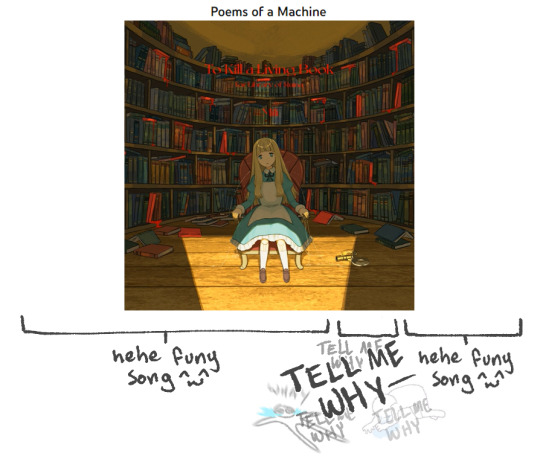
cant come in to work today they put on poems of a machine again. yea its gonna be an all day thing. sorry
#point @ image. haha i tell litle joke . the entire second half of the song guts me like a fish routinely <33#projmoon#piktalk#songs that make me want 2 write another manic essay. songs that . yeag ;;
89 notes
·
View notes
Text
due to personal reasons i will be donning my seal-coat and escaping my responsibilities by returning to the sea
#i was not built for college i was built to be a lil guy#would very much prefer to be a selkie catching fish rather than just some guy writing essays#selkie#selkies#aough#mythical creatures#mythology#selkie folklore#folklore#dragons chatting
149 notes
·
View notes
Text
Perhaps the ocean is a little bit obsessed with grian and knows that if he gets a mending book he will leave. so its withholding it. to keep him fishing
#fishing entrapment if you will#the s10 ocean is the new s5 jungle in this essay-#hes gonna be consumed by the sea. sad. oh well!#grian hermitcraft
33 notes
·
View notes
Text
it will always be a crime to me that we never got to see how skipper and ash met
#banana fish#this leads to a much bigger topic that idk if im equipped to handle atm.#its a topic i think about a lot tho if i was willing to put in effort to post i could write a whole researched essay on it me thinks.
51 notes
·
View notes
Text

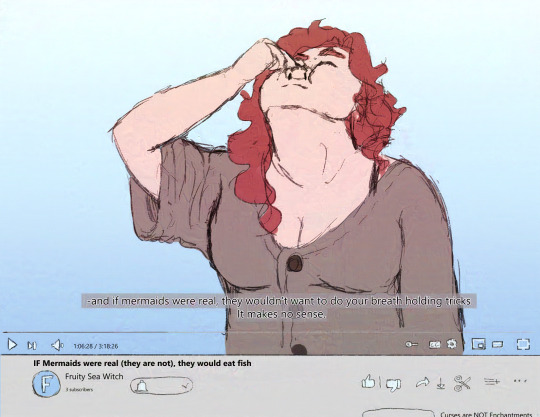
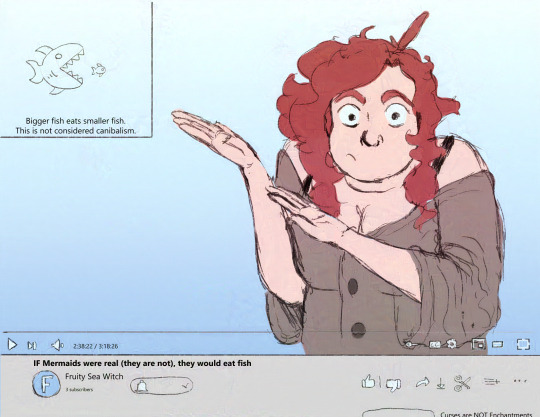

Pomegranate starts a video essay channel.
#art#mermaid#mermaids#pomegranate#fish and chips#digital art#fantasy#monstergirl#video essay#really it started out as gesture and expression practice#silly#sketch#doodle
31 notes
·
View notes
Text
What Is and Isn't a Fish: an Essay and Guide by Fishyfishyfishtimes
A simplified list of the animals I discuss can be found here!
Hello folks! I created this post to have a kind of definitive essay/explanation of what is and isn't a "fish", starting with defining the term and going over animals that fit and don't fit the bill. As other fishblr artists, writers and educators must know too well, some people are confused about where this term begins and ends, mistaking other aquatic animals for fish. I have my fair share of arthropods and cnidarians as fish fact requests in my own askbox, heck, some years back a friend of mine asked me if clams were fish. The event that finally made me decide to write this was someone requesting that a fish-only account draw a crustacean, pondering to themselves if they count as fish.
I don't want to hold it against these people. It's impossible to know something when you've never been taught! So that's what I'm here to do, hopefully achieving a pretty correct and universal view ^^' If I make any mistakes please correct me. I'm learning all the same as everyone else is.
Definition of fish
Immediately, we run into a bit of a problem with the definition of fish. See, what the term "fish" means has fluctuated for centuries! For a long time, pretty much any animal that lived in water was a "fish" — I say "pretty much any" instead of "every" animal because for a long time sessile animals like sponges or corals were thought to be plants. This is why we have such remnants in our language like shellFISH, starFISH and jellyFISH, they lived in water so they were called such!
Occasionally these definitions would be changed for cultural convenience too. Many Christian churches take part in Lent, and in the Catholic church red and white meat is forbidden on Fridays and Ash Wednesday. In the Middle Ages, in my own country, Finland, this abstinence of red and white meat could last up to 140 days! To make fasting easier, many animals were labelled fish for convenience so they could be eaten as well. These newfound "fish" included seals, beavers and swans, pretty much just anything that was aquatic or semiaquatic in nature.
Nowadays just going off of looks or behaviour won't do, though. There has been much more of an effort to define fishes coherently based on their anatomy and phylogeny, which is great! Problem is, that's easier said than done: fishes are an extremely diverse group, and uh.. not really a single group, either. I'll show you:

As you can see from this heavily simplified phylogenic tree, fishes are not a singular group like, say, mammals are! The animals that we group under "fish" are actually a part of several distinct lineages of animals, some more closely related to us than each other. Heck, tetrapods, which include amphibians, reptiles*, and mammals, are fish themselves! Phylogenetically speaking. Our ancestors were lobe-finned fish, and, well, you never stop being the previous taxon even when you evolve into something else. If you try to exclude tetrapods, no such unified group as "fish" exists. Still, when discussing fish, we tend to want to avoid talking about every vertebrate ever and instead focus on the very specific aquatic ones we mean when we say "fish". This is why many definitions of the term "fish" still exclude tetrapods, even if we share a common fishy ancestor. "Fish" describes more of a lifeform than it does a clade, much like the term "worm"!
(*birds are reptiles! This could be a whole post in and of itself, but I'm not here to write about that. Someone else has most likely taken up the task!)
Hooray, it's definition time! As stated previously, fishes are an extremely diverse group of thousands of species, and what terms might apply to the Atlantic cod may not apply to the yellowfin tuna or giant mudskipper, let alone a Pacific lamprey! Encyclopedia.com defines a fish as "an ectothermic chordate that lives primarily in water and possesses a cranium*, gills that are useful virtually throughout life, and appendages (if present) in the form of fins". Encyclopedia Britannica notes that "the term fish is applied to a variety of vertebrates of several evolutionary lines", instead highlighting five classes. These five classes are left partly unspecified, but ones that are mentioned are jawless fish, cartilaginous fish and bony fish (which still includes tetrapods, however), and the two classes left can be assumed to be two classes of extinct fish. Wikipedia defines a fish as "an aquatic, craniate**, gill-bearing animal that lacks limbs with digits". Tim M. Berra, an academy professor and ichtyologist, defines fish as "poikilothermic***, aquatic chordate with appendages (when present) developed as fins, whose chief respiratory organs are gills and whose body is usually covered with scales".
(*cranium=upper part of the skull **craniate=an animal with a skull ***poikilothermic=an animal whose internal temperature varies considerably)
From these more or less detailed definitions we can gather many defining features for fish: a cranium-having chordate, primarily aquatic, gill-bearing and uses gills as their main respiratory organ, lacking any limbs with digits, instead having their limbs be in paired and unpaired fins when present. Most fish are also ectothermic, meaning their body temperature is determined by their environment, but some can heat up parts of their body or their entire body in the case of the opah. Most fish also have scales, but not all, just like how most fish are fully aquatic, but some like lungfish or mudskippers can spend considerable time out of the water. Such is the way of these magnificent and diverse animals!
Finally, with all this out of the way, we can get into...
What is a fish!
Here, I will be detailing animals that are fish! Well, at least the broadest strokes; there are more than 30 000 fish species and if I listed them all we'd be here all life. I shall instead go over the major classes and list, in short, some groups that belong in them.
Jawless fish (Superclass Cyclostomi)
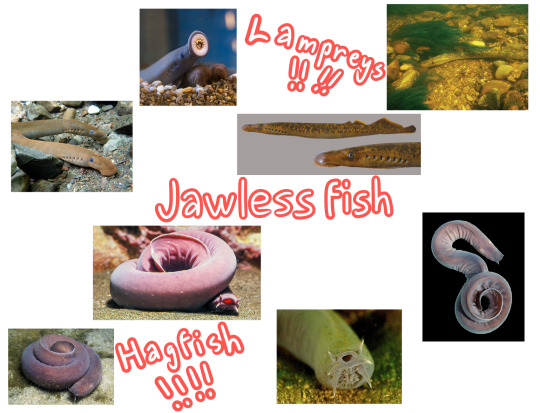
Jawless fish are often a topic of debate, especially in matters of their relation to each other and to jawed vertebrates. Evidence seems to point to hagfish and lampreys being closest related to one another and to lampreys being more closely related to jawed vertebrates than to hagfish (which would make hagfish craniates but not vertebrates). In the phylogeny tree above I decided to portray hagfish and lampreys as a monophyletic group, as molecular studies and microRNA analysis seems to point to a monophylegic superclass. Please note that this could go either way, though.
Jawless fish is a group containing two extant fishes, hagfish (class Myxini) and lampreys (order Petromyzontiformes)! Jawless fish are more "primitive" than other groups, for example both lack true vertebrae and scales. Still, they both have craniums and gills and they are aquatic, and so they have earned their place among fish!
Cartilaginous fish (class Chondrichthyes)
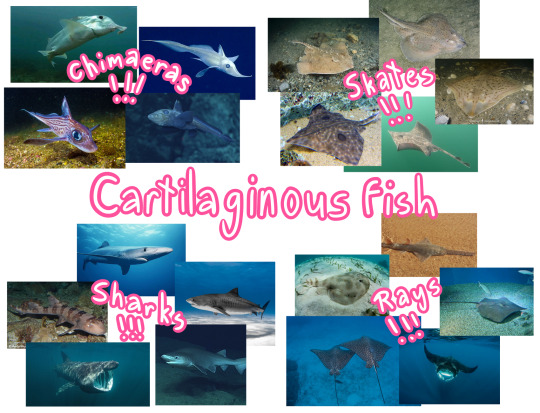
Surprisingly, I've found that this group has a lot of confusion surrounding it. I have received many a request confirming if sharks are fish, or asking if I'd cover a shark "even if it's not a fish". So I'll say it now: good news, sharks are indeed fish! So are their cousins, rays, skates and chimaeras, also known as ghost sharks! All of these fish have a primarily cartilaginous skeleton, tooth-like dermal denticles and lack gill covers and a swim bladder. Out of all the sharks, I also want to highlight that the whale shark, despite its confusing name, is a shark and not a whale. So, it is a fish!
Ray-finned fish (class Actinopterygii)
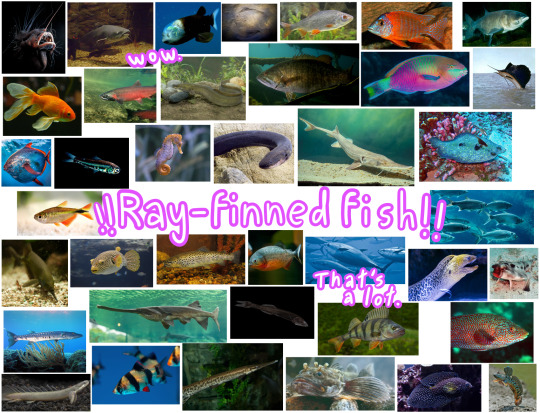
Name any fish, and there's a 96% chance the species name you said belongs to a ray-finned fish. Unless, like, you really like sharks. But this isn't about them.
Ray-finned fish are the biggest group of fish and incredibly diverse! It has your seahorse, your pufferfish, your bass, your tuna, your anglerfish, your clownfish, your salmon, your sturgeon, your lanternfish, your perch, your oarfish, your gar, your sardine, your moray eel... and this is only a tiny, tiny fraction of the groups that belong to this class! Defining features of ray-finned fish are that they tend to have a swim bladder and a bony skeleton (some exceptions though. Sturgeons, for one, have evolved a cartilaginous skeleton but they're still ray-finned fish). The largest group of ray-fins, the teleosts, also have leptoid scales, which are thinner and more flexible and grow with growth rings.
I want to bring special attention to some members of the ray-finned fish which tend to have a lot of confusion surrounding them and their heritage: eels and seahorses. Many people think these two are not fish due to their strange anatomy, like lack of scales or (many) fins and their elongated bodies, and I wouldn't blame them! Seahorses belong to family Syngnathidae, which also includes seadragons and pipefish. Eels, meanwhile, make up the order Anguilliformes. All of these long friends of ours are fish!
Lobe-finned fish (clade Sarcopterygii)

I shall merely focus on the fishy fishy fish individuals of this class, which excludes tetrapods. Lobe-finned fish house the two extant species of coelacanths, and six extant species of lungfish! These fish are bony and their fins are placed at the tips of fleshy, lobelike stalks, resembling the limbs of tetrapods. It is thought that the common ancestor of coelacanths and lungfish and tetrapods had similar structures that then became the four limbs the members of our clade typically have. Coelacanths and lungfish are wonderful fishes and deserve a lot of love and respect, not only because they're our closest cousins but because they're unique and we have so much to learn about them!
So, these are the fishes! There are also extinct groups of fish, namely class Placodermi (armoured fish) and class Acanthodii (spiny "sharks"). I'm moreso an extant fish account however, and so I shall move onto...
What isn't a fish?
Now we get into the real meat of this post. Without further ado, here are some aquatic friends of ours that can be mixed up with fish very often!
Crustaceans (subphylum Crustacea)
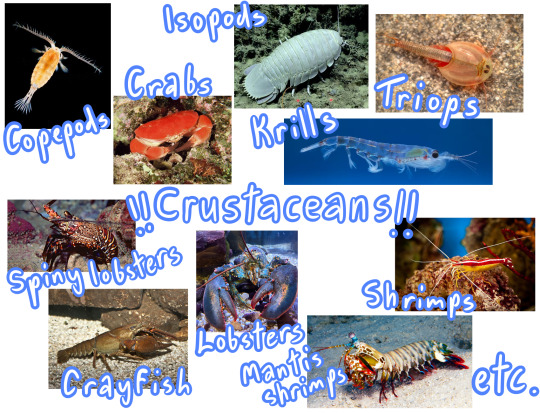
Many of our hard-shelled many-legged friends belong here! Crabs, lobsters, crayfish, shrimp, krill, isopods, triops, barnacles, copepods, you name it! Even though many crustaceans are aquatic or semiaquatic and have gills, you'll find that they're invertebrates that lack an internal skeleton (so no cranium, not even vertebrae)! We still love them though!
Mollusks (phylum Mollusca)

Creatures both soft and hard-shelled! Cephalopods like octopuses, squid, nautilus and cuttlefish, bivalves like clams, mussels, oysters or scallops, gastropods like sea slugs and snails and chitons go here! These friends of ours are also aquatic and have gills, some even have the suffix -fish (cephalopods used to be called inkfish, even!), but their lack of an endoskeleton is even more obvious than the crustaceans'. They're invertebrates, and therefore not fish!
Chelicerates (subphylum Chelicerata)
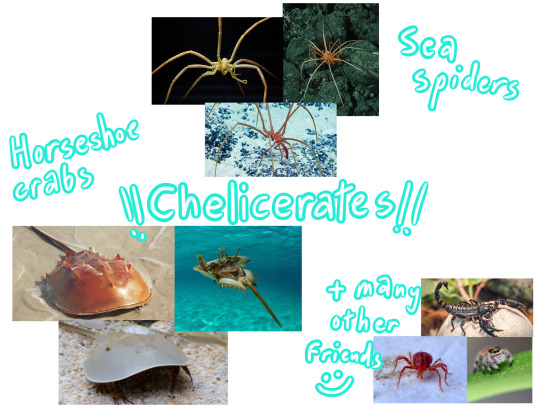
This group has many animals that are very hard to mistake for fish, namely spiders and scorpions, but horseshoe crabs and sea spiders are two groups of extant marine chelicerates! Both groups are aquatic, and horseshoe crabs have gills. However, they're both invertebrates, lacking a cranium or vertebrae. Other aquatic chelicerates exist, but they're usually very small, like water mites.
Cnidarians (phylum Cnidaria)

This phylum has the sessile corals and sea anemones and the usually more mobile jellyfish and siphonophores (includes the infamous Portugese man o' war!). I imagine corals and sea anemones are mistaken for fish less due to their sessile nature, but they're good to bring up nevertheless. None of these animals have a backbone, or, any bones really. They lack gills, they lack fins, they even lack the bilateral shape of fish. Jellyfish, despite the name, are indeed not fish! Some people suggest the name sea jellies be used for them instead, and I think it's much cuter.
Echinoderms (phylum Echinodermata)

Animals like starfish, sea urchins, brittle stars, sand dollars, sea cucumbers and feather stars go here. It seems that this pesky "-fish" -suffix is hard to shake off, as now we have the starfish. Once again, all of these slow-moving bottom-dwelling friends of ours are invertebrates, as they lack vertebrae or a cranium. Interestingly though, they are among our closest invertebrate relatives! So we ought to give them some props for that. I also want to mention that starfish can also be called sea stars, which ought to lessen confusion about their being too.
Comb jellies (phylum Ctenophora)

Comb jellies look a lot like jellyfish, but they belong in their own unique phylum! They have the same deal going on; they are invertebrates, they lack gills, they lack a cranium, they are simply aquatic.
Lancelets (subphylum Cephalocordata) and tunicates (subphylum Tunicata)
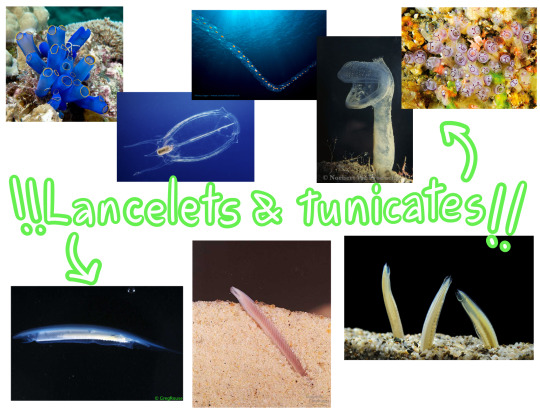
A double feature, because I wanted to save space didn't want these guys to be all alone! Lancelets and Tunicates, like sea squirts and salps, are chordates, which you can find in the phylogenic tree I drew all the way in the definitions section. They share many a feature with vertebrates, like a bilateral bodyplan, a notochord at some stage of life and a post-anal tail, but I'm afraid they're still not fish. They lack a cranium and their notochord does not develop into a vertebral column! Sorry friends, you tried. We can still hang out at the chordate convention.
Annelids (phylum Annelida)

The infamous bobbit worm, bone-eating worms, sea mice, giant tube worms, feather duster worms, spoon worms, bristleworms in general, leeches... many, many worms go here! Pretty self-explanatory: they are invertebrates, even when they live in water. They're extremely cool invertebrates too! I suggest taking a look at some of them, there's many interesting species.
Flatworms (phylum Platyhelminthes)

Flatworms are another very diverse group of worms, having many species both terrestrial and aquatic, however mostly I want to put attention into the free-swimming marine flatworms. They may swim beautifully (and fence with grace), but they are nevertheless invertebrates! Flatworms can live a variety of different lifestyles, from predators to parasites.
Amphibians (class Amphibia)

We've made it into vertebrates now! Amphibians include frogs, salamanders, and caecilians. While they have limbs with digits in their adulthood*, they can be easily confused for fish in their larval stages! This is no surprise, as they use gills to breathe underwater and tadpoles lack any limbs at all for a while. Many amphibians later transition into a terrestrial or semiaquatic way of life and lose their gills, not to mention gain their digit-having limbs.
(*excluding caecilians)
...Well, many amphibians do this, but not all. It's important to mention there are also species of aquatic salamanders which can bear great resemblance to fish with their elongated bodies! Amphiumas, which are sometimes mistakenly called "conger eels" (which is an actual species of fish), are aquatic salamanders with small residual limbs and both working gills and lungs. Giant salamanders and mudpuppies/waterdogs have lungs and gills as well, and lead an aquatic lifestyle — olms are close relatives of mudpuppies. Sirens, meanwhile, lack hind limbs and only have small front limbs, along with retaining their gills in adulthood. Among aquatic salamanders I also want to bring up one most often talked about species: the axolotl! They remain in their larval form, have external gills and lead an aquatic lifestyle. It can be hard to tell with aquatic salamanders sometimes, but these friends of ours are amphibians and not fish, even if they've rejected the land life.
Caecilians are a bit less known overall, but they can also cause a lot of confusion due to their long, limbless body. While most caecilians live underground, some are aquatic in nature, and can therefore be mistaken for fish! However, caecilians breathe via the use of their lungs and through the skin and don't have any gills at all.
Reptiles (class Reptilia)

Most commonly mistaken for fish in this group are sea snakes, sea kraits and water snakes, sea turtles, turtles, penguins, and other (semi)aquatic birds. Sea snakes and water snakes bear a very strong resemblance to eels, but they are indeed just snakes adapted to an aquatic or a semiaquatic lifestyle! The same goes for sea turtles, turtles overall, and penguins. They all need to breathe air and they lack fins, even if their flippers, webbed feet and built-in paddles may look like fins! They also have wholly different types of scales (or feathers!!) than what fish have, even if they share the feature. I assume that other aquatic reptiles, like the marine iguana and crocodilians are better read as reptiles thanks to their limbs with digits, but I want to give them a reptile shoutout anyway. They’re aquatic or semiaquatic, but they are air-breathers and fin-lackers all the same!
I also want to mention one specific extinct group of reptiles, ichtyosaurs! These marine reptiles were rather shark- or dolphin-like in appearance, which is actually a really good example of convergent evolution! Like all other reptiles, they also needed to breathe air and they had... erm... well, I'm not sure if I can call the bones in their flippers digits, but, that's what they used to be, so...? They were cool reptiles and among my favourites! There were many other aquatic reptiles too, but I will only mention just the ones now. A paleontology account would be better-suited to list you allll the marine reptiles.
Mammals (class Mammalia)

Our home class! Some of the aquatic friends we have in this class include whales like baleen and beaked whales, dolphins (orcas go here), porpoises, belugas, narwhals and sperm whales, pinnipeds like seals, sea lions, walruses, and sirenians like manatees, (occasionally known as sea cows) and dugongs! We also have some semiaquatic buddies like hippopotamids, otters, beavers and platypuses! Whales and pinnipeds especially often cause a lot of confusion due to their very streamlined, fishy appearance. They are, however, air breathers that feed their young with milk (some dolphin calves are even born with some hair), and their ancestors were land mammals! The same goes for pinnipeds and sirenians too. True seals, fur seals and sea lions still have fur even! Hippos, otters, beavers and platypuses are a bit more obvious as mammals with their fur and.. distinct air-breathing.. but I wanted to mention them anyway. Their adaptations to aquatic life are just one example of how fascinating evolution can be!
And here we are! A hopefully comprehensive list of fishes and non-fishes, beginning with the ever-shifting story of the term "fish", phylogeny, and why some animals are called fish when they really aren't. I hope you have found useful and interesting information in this post, and perhaps learned something new! I bid you a farewell! :D
#fish guide#fish essay#fish#fish facts#fishfact#marine biology#biology#zoology#long post#jawless fish#cartilaginous fish#ray-finned fish#lobe-finned fish
255 notes
·
View notes
Text

im gonna draw a nicer one of these guys later but man am i in love with this fish. full of love (probably) and parasites (definitely)
#fish#mola mola#i just wrote an essay/personal statement about these guys and wanted to doodle a 10 minute one :)#i had fun doing this#i need to draw these guys more#they were my favorite thing to draw as a kid#what wonderful creatures#gonna draw a nicer one later#this was for play
40 notes
·
View notes
Text
Its been a while since i made a post about fish and their biology, so here is today's wet beasts, THE PUFFERFISH also known as the ballonfish, puffer fish are their own own family scientifically known as "Tetraodontidae!" They are morphologically similar to the closely related porcupinefish, which have large external spines, unlike their cousins thinner and more prittle spikes
And Today i have two species of puffer that i adore and i want to share with you
One of em is the
Valentin's sharpnose puffer


Also known as the saddled puffer, because he looks like he has a little saddle on his silly little back
His binomial name is Canthigaster valentini
He is in the genus Canthigaster (seen in its sciency name)
This badboy lives in very complex social groups that kinda feel like harems..! The dom male or female has a bunch of other fish to mate with, they are also kinda territorial and really like their personal space!
While in the harem mood lets talk about their eggs and larvae
Their eggs range in size between 0.68 and 0.72 mm in diameter, making them some of the smallest in the family Tetraodontidae! (So small :'3)
The eggs are spherical with nine radial layers, the outermost layer possessing strong cleaning properties helping them avoid infections, even fish respect their personal hygiene.
Lets move on to the other star of today's wet beast THE WONDEROUS LONG SPINED PORCUPINEFISH
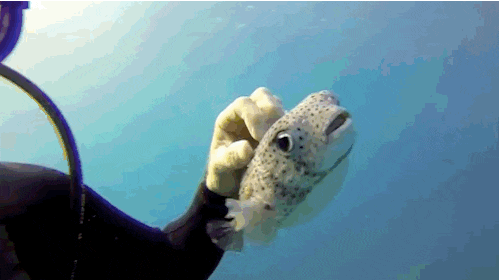

This cute little fellow is also known as the freckled porcupinefish because of its little spots all over its face!
They are found over the muddy sea bottom, in estuaries, in lagoons or on coral and rocky reefs around the world in tropical and subtropical seas!
Their are on the genus Diodon and their fancy biology name is Diodon holocanthus!
A fun fact! They spawn on the surface of the water at dawn and or dusk!
They are in fact both poisonous and venomous, so i would avoid touching them, but looking at their cuteness form afar is really great on its own!
#yeah :)#essay#marine science#marine animal#marine animals#marine biology#marine life#PUFFERFISH#pufferfish#this took way to long#i love fish so mucj
76 notes
·
View notes
Text
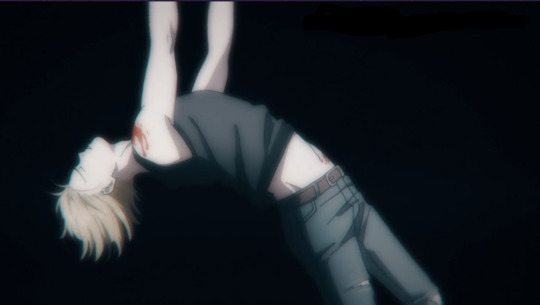
Words cannot describe how absolutely beautiful this scene was.
#I could probably write an essay#about that entire episode#This anime just has a way with storytelling that you can't get from anything else#banana fish#banana fish spoilers#ash lynx#prayer x
18 notes
·
View notes
Text
Thinking about the implication that Gillion is the one who has constructed his trial makes things all the more fucked up.
When the donjon uses the word "sin", it is pulling from Gillion's own interpretation of what a sin is: and what Gillion sees as a sin is his inability to bear pain. In the sun temple he confesses that he doesn't want to be the chosen one, that he feels he can't bear the responsibilities and that makes him sinful. In the end of the trial, he confesses he hates the elders, he hated the failure, he hated waking up in the morning and that makes him sinful. Gillion feels sinful for wanting to be normal, for being abused, for feeling depressed and even suicidal. When the donjon interrogates Gillion for his sins, Gillion is judging himself harshly from a very flawed view of what sin is.
His "wrath", his "pride", his "impulsiveness". Although Gillion has these flaws, the ways in which he identifies them in his past is such a worrying sentiment. He puts blame on himself that he killed humans in the first case, even if he couldn't have known better. He puts blame on himself that he was self absorbed in the second case, even if he couldn't have known better. He puts blame on himself that he attacked a navy officer in the third case, even if he couldn't have known better. When Gillion reflects on his past and projects his own failure onto it is so deeply troubling - he's weaponising his own hindsight against himself. His sin is hating the elders and it's a sin because what happened must have been a fault on his part. Gillion didn't say that it was the elders fault he failed, just that he hated the elders for waking him up TO fail. THEY didn't fail him, they WATCHED him fail. There's a difference between these two sentiments.
And what we also need to bring up is that even if Gillion tried his best in each case, it still wasn't good enough. There's a reason why Charlie had to make wisdom saves just to see if Gillion felt what he did was right. No matter how far he comes he still doubts himself.
I think that there's good reason why the trial didn't have a resolution. Gillion's trial still did little to trump his fear of his abusers, it still did little to make him feel confident. He still has to physically prepare himself in case he failed because the pain of failure still overwhelms him. And you know even if Gillion says that he doesn't need their validation, Gillion still constructed his own trial and bore it in the hopes he wouldn't be guilty. How can Gillion resolve his own trial when he's still bearing so much emotional baggage? Even if he had recieved his verdict, would it really have resolved anything? Chances are it only would have made Gillion worse in one way or another.
The way Gillion held himself was amazing in some regards, but the fact is that Gillion constructed his own trial because he judges himself as a screwup. He WAS banished, he WAS guilty. This trial was a judgement of his current state rather than him at ALL forgiving himself for what he did. This trial is not enough to forgive him of his past, only to see if he "will no longer be destined to ruin that of which you touch". No longer be destined - which doesn't mean he WON'T, just that he's no longer "destined". And oh boy the fact that for all this time Gillion has felt that he was destined to fail? That he's been waiting EVERY day for him to ruin everything around him? Everything he touches? To ruin Jay or Chip or to fuck something up the next time he tries to help like the chosen one he's meant to be?
Dear deities above, why did the donjon have to be a reflection of Gillion's inner conflict. That's so messed up. It's not healthy for Gillion to continue to deal with all this alone; he's already dealt with everything alone for so long. How I wish for someone, ANYONE to tell him that it's not his fault...
#ep 79#jrwi spoilers#jrwi riptide spoilers#jrwi gillion spoilers#📚 my posts#📝 essays#worst thing about writing this is i didnt cover everything#how did they fit so much emotional damage into this fish#just roll with it#jrwi riptide#gillion tidestrider#cw sui ideation#cw abuse mention#cw child abuse#cw childhood trauma#tw sui ideation#tw abuse mention#tw child abuse#tw childhood trauma
153 notes
·
View notes
Note
whoa thank you so much for the explainantion, i wasn't sure where to find the intro post so that was perfect. Also I didn't realise that the artist Fish in a Birdcage was from ireland, what great info ee :)
Without knowing very much (so absolutely feel free to ignore if it doesn't suit ya), perhaps if playing an instrument is ever something he gets to do, he could play a fiddle or even a banjo lol,
will look forward to learning about this guy and other characters in his universe (i also have no idea what an iterator is so, learning curve)
thanks again :]
of course! i'm glad to explain the stuff
OOOOOOOOOOGHHHHRHHG... FISH ON A BANJO,,, i'll have you politely know that i adore that idea a lot. assigning characters instruments and such is one of my favorite things to do! Fish already has hurdy-gurdy assigned to his name (those apparently may have evolved from fiddles, huh, neat!), but oh i would Not mind puttin a banjo into his hands
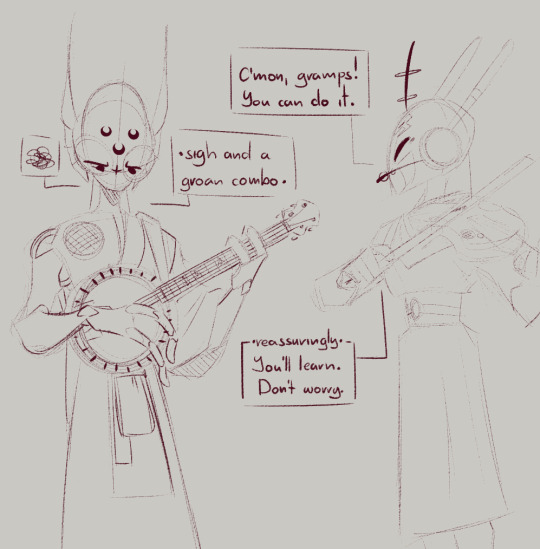
oh! are you new to this fandom? i'd very much recommend looking into the game Rain World either by buying it, watching a playthru or going straight to the lore videos on youtube yourself! these guys are all ocs of mine based off of that, so it might be nice to get to know the canon lore from which ive built them!
#Spot says stuff#rw#personally am a big fan of variety in fandoms and people developing their own opinions on stuff so i!! encourage you to look into the og-#-material. there's quite a few lore video essays on utube at this point i'm sure. and then the wiki is there too for specifically the lore#i can Hear how much fish would be yapping after playin the banjo for a bit...#ive played on like. a fake out banjo (6 strings guitar tuning) for a few hours once n STARS my left shoulder was killin me afterwards
28 notes
·
View notes